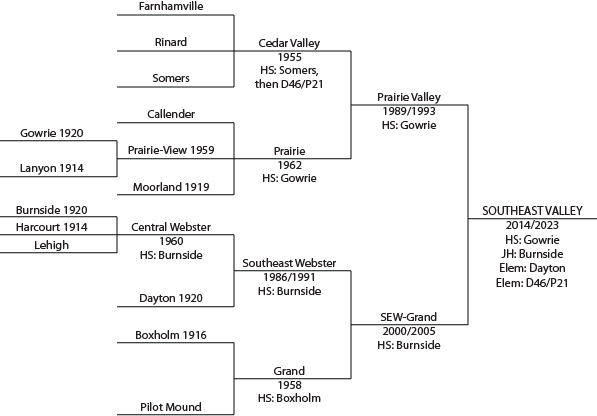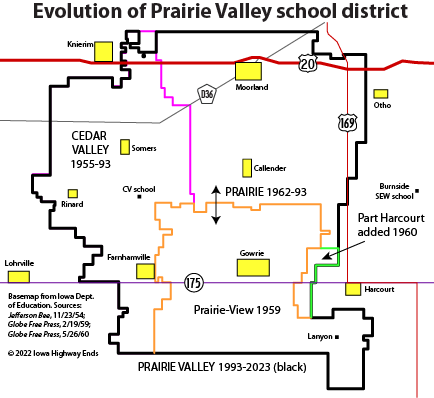The Southeast Valley school district, which will become official in mid-2023, can trace its history to 1914.
One of the first experiments in school consolidation, to be tried in this part of Iowa, will be at the town of Lanyon, just north of Paton township in Webster county. By unanimous petition of the patrons of the district No. 1, in Paton township, known as the Gust Burgh school, that district will be added to Lanyon and the same will be voted on by the patrons of the consolidated district within a short time.
— Jefferson Bee, June 17, 1914
Harcourt, just to the north, consolidated weeks after Lanyon, and/but the two communities would not be unified school-wise until Southeast Valley’s whole-grade sharing began in 2014. A 10-room, 2-story, $18,000 Lanyon Consolidated School building was dedicated May 1, 1917 (Gowrie News, 5/10/17). The structure would exist until the early 2000s. Multiple other towns in the area would form consolidated districts in 1919 and 1920.
The journey from Lanyon to Southeast Valley is long and big — as in, two-thirds the size of Rhode Island big. To tell that story, we need a family tree, or since I started work on this in March, a bracket with a couple round-robins and “pigtails”.

(I am extremely my parents’ child.)
As the family tree shows, there are a lot of former districts involved. The map below covers the top half only, the Prairie Valley district. The Southeast Webster-Grand district is east of PV, and not drawn in. (I hope the district differentiation is clear; I know it’s a lot of lines.)

At the bottom of the map is Lanyon, with the four-square-mile square in Greene County that was Paton No. 1 school to its south.
Through the Jefferson Bee, Jefferson Herald, the Globe Free Press/Paton Patriot/Rippey News and other sources, here is all I know about the district’s history.
-
- Farnhamville, Rinard, and Somers merged into Cedar Valley in 1955 (JB, 11/23/54). That’s about the western third of the future PV district. The name is related to Cedar Township in Calhoun County and Cedar Creek, which flows into the Raccoon River northeast of Ralston. Cedar Valley bordered still-independent Knierim on two sides, but Kneirim eventually became part of Manson-Northwest Webster.
- Among the Cedar Valley school board’s actions in its first month of existence: A 3-2 vote to close the building at Rinard (1950 pop. 115; 2020 pop. 38). This did not go over well. A lawsuit was filed claiming the district was illegally formed. The board reversed its decision and turned Rinard into the junior high (JH, 7/21/55, 9/1/55; JB, 9/27/55).
- Farnhamville’s high school closed the year after Cedar Valley was formed (JH, 4/5/56).
- Boxholm and Pilot Mound merged to form Grand in 1958 (Ames Tribune, 4/12/58 — two paragraphs but it’s all I need)
- Lanyon, an unincorporated village 3 miles south of Harcourt, merged with Gowrie in 1959 to form a district called Prairie-View, sometimes written with a hyphen, sometimes not. Lanyon’s school lasted three years as PV’s junior high. It was not torn down until 2002-04 (aerial photos).
- Burnside, Lehigh, and Harcourt consolidated as Central Webster in 1960 (Des Moines Tribune, 3/23/60). A fraction of the Harcourt district went to Gowrie (GFPPPRN, 5/26/60).
- Prairie-View merged with Callender and Moorland in 1962 to form a district just called “Prairie” (GFPPPRN, 4/26/62).
- Cedar Valley kept all three schools open until it opened a new complex at the intersection of D46 and P21, a few miles away from each town. It then held everything-must-go auctions at the old schools (GFPPPRN, 10/25/79), which were torn down by May 1983 (aerial photos).
- By all rights, that 1979 site, now a K-4 school for Southeast Valley, should be attributed to Somers, not Farnhamville. (See, for example, this Fort Dodge Messenger brief.) Somers is the nearest incorporated community and the school is technically in Somers’ 50586 ZIP code.
- There was a potential of Paton becoming part of the Prairie district (GFPPPRN, 1/18/62). Paton and Moorland were effectively on the clock because their high schools would lose state aid in 1962-63.
- But by that spring, Paton was leaning toward Churdan. If consolidation did not get finalized by July 1, Paton would have to “tuition out” its high school students to Churdan (JB, 4/10/62). Long story short, it didn’t, and the Greene County Board of Education got excoriated by a district judge in a ruling printed in full in the Lohrville Enterprise and Farnhamville Index (4/11/63). The Paton-Churdan district took effect in 1964 (JB, 7/9/63).
- The Pilot Mound school definitely closed in 1985 (Des Moines Register, 7/26/85).
- I don’t have a closure year for either Harcourt or Moorland, but both had their original school buildings demolished between 1972 and 1983 (aerial photos). Lehigh’s school was also torn down in the 1970s.
- Unrelated to all that: On April 3, 1962, the Jefferson school board removed its ban on married women as teachers (JB, 4/3/62). The change was prompted not by any sense of equality, but because there was a short supply of teachers and the state had recently imposed a requirement that elementary teachers have bachelor’s degrees.
- In 2023, Southeast Valley will include 11 incorporated communities: Boxholm, Callender, Dayton, Farnhamville, Gowrie, Harcourt, Lehigh, Moorland, Pilot Mound, Rinard, and Somers; and two unincorporated communities, Burnside (where the middle school is) and Lanyon. Only Dayton and Gowrie have a population above 400.
